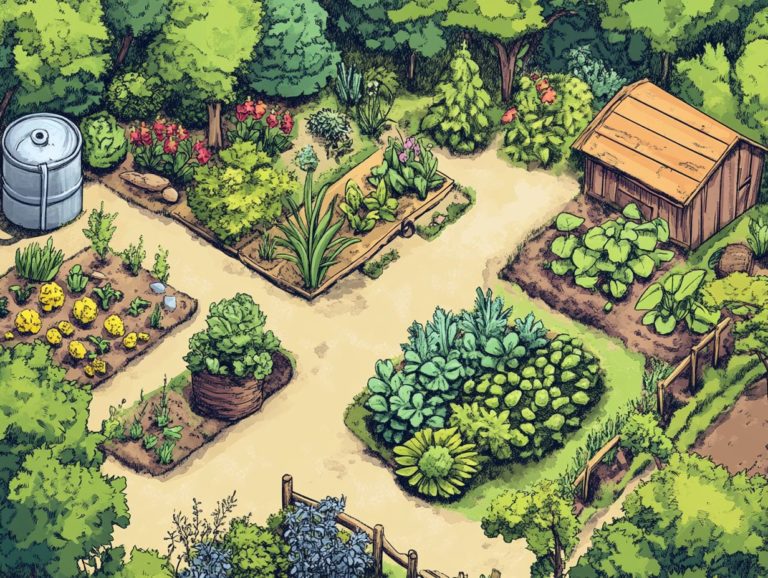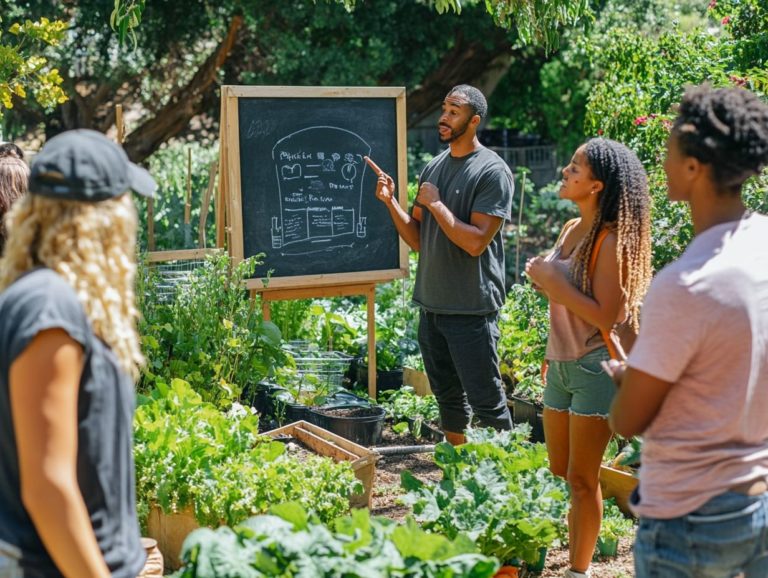40. 7 Creative Ways to Engage Youth in Permaculture
Permaculture presents a unique opportunity for you to connect young people with nature. It also instills a sense of responsibility for the environment.
This exploration delves into seven imaginative strategies designed to engage youth in permaculture practices. By incorporating hands-on activities, artistic projects, workshops, and tech-driven initiatives, these approaches enhance learning and empower young minds to innovate.
Uncover how these captivating methods can ignite a passion for sustainability and equip the next generation with essential skills for a promising future.
Contents
- Key Takeaways:
- 1. Use Hands-On Activities to Teach Permaculture Principles
- 2. Incorporate Art and Creativity into Permaculture Projects
- 3. Organize Permaculture Workshops and Events for Youth
- 4. Create a Youth-Friendly Permaculture Garden
- 5. Encourage Youth to Share Their Ideas and Innovations
- 6. Introduce Permaculture in Schools and Youth Organizations
- 7. Use Technology to Engage Youth in Permaculture
- How Can Permaculture Benefit Youth?
- What Are Some Examples of Successful Youth Permaculture Projects?
- What Are the Challenges of Engaging Youth in Permaculture?
- How Can Permaculture Help Youth Develop Important Skills?
- What Are the Long-Term Effects of Engaging Youth in Permaculture?
- How Can Youth Be Encouraged to Continue Practicing Permaculture in the Future?
- Frequently Asked Questions
- 1. What is permaculture and why is it important to engage youth in it?
- 2. How can I get youth interested in permaculture?
- 3. What are some fun ways to teach youth about permaculture?
- 4. Can permaculture be integrated into school curriculums?
- 5. How can I involve youth in permaculture projects in their communities?
- 6. How can I support youth who are interested in permaculture?
Key Takeaways:
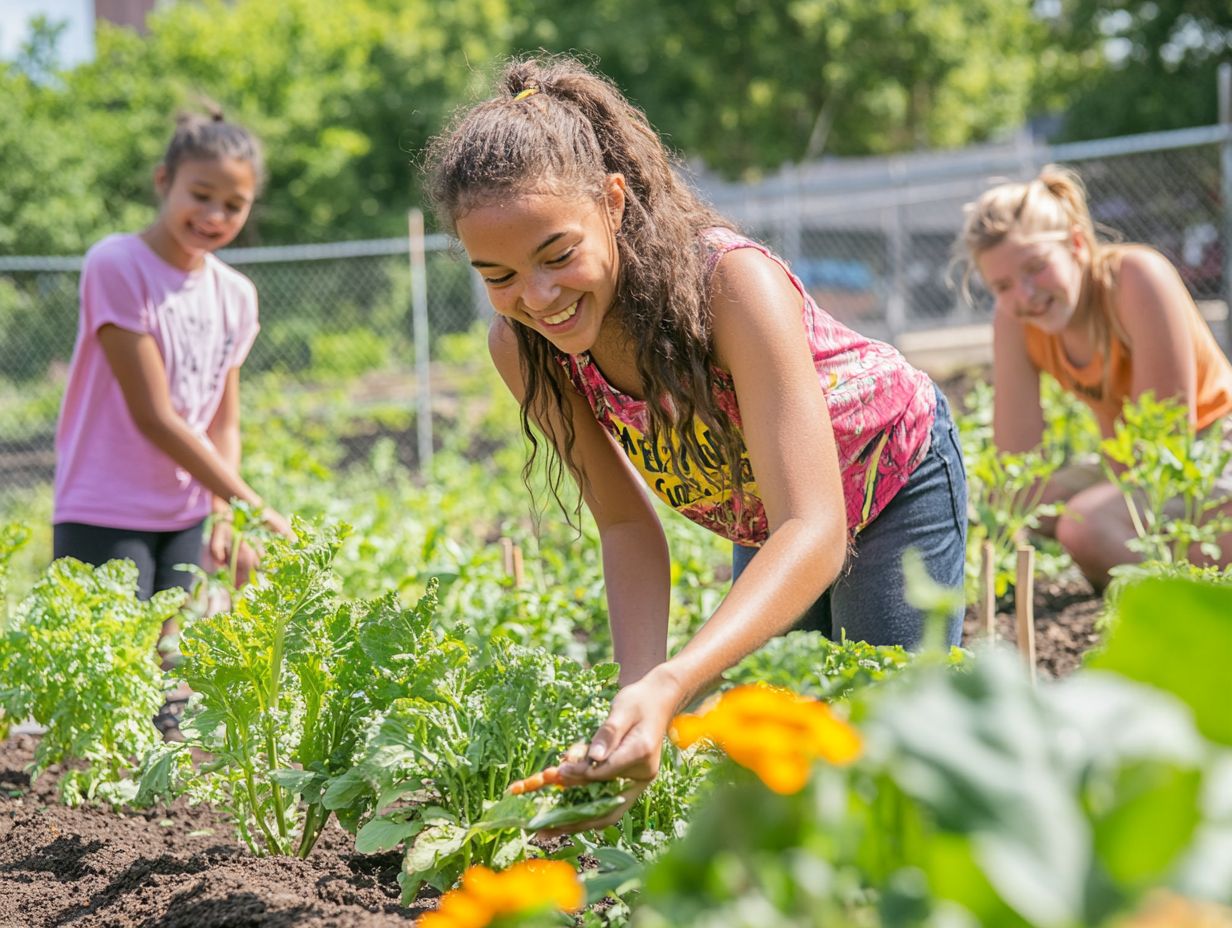
- Incorporate hands-on activities to teach permaculture principles while engaging youth in a fun way.
- Utilize creativity and art to make permaculture projects more appealing to youth.
- Organize workshops specifically for youth to learn and practice permaculture techniques.
1. Use Hands-On Activities to Teach Permaculture Principles
Hands-on activities are vital for teaching permaculture principles. They offer immersive experiences that deepen understanding and engage youth in community projects.
For instance, when you involve children in creating a butterfly garden, you’re not just teaching them about habitats; you’re also sharpening their observation skills as they monitor insect activity. When you design and maintain a seasonal vegetable patch, you enhance their grasp of resource cycles, from planting to harvesting.
Implementing activities like composting or setting up rainwater collection systems fosters practical skills. These creative projects connect young learners with nature and cultivate responsibility and stewardship.
2. Incorporate Art and Creativity into Permaculture Projects
Adding art and creativity to your permaculture projects elevates the design process. This approach enhances both the aesthetic and functional aspects of garden design.
This infusion of art acts as a catalyst for collaboration and exploration. Using various artistic techniques whether sketching, modeling, or digital design tools can help visualize concepts clearly.
These design tools create an environment where observation is paramount. You can evaluate and provide feedback on the evolving landscape alongside your peers. Such interactions lead to a more engaging learning experience that blends art with science.
3. Organize Permaculture Workshops and Events for Youth
Organizing permaculture workshops specifically for youth cultivates understanding of environmental education. It actively involves them in community projects that promote sustainable living.
Structure these workshops to include a blend of informative sessions, hands-on activities, and group discussions. Participants can dive into practical exercises like planting gardens or setting up compost systems.
Your teaching methods can include storytelling, visual aids, and collaborative projects. Introducing permaculture techniques shows how sustainable practices weave into daily lives.
Developing action plans helps apply valuable lessons learned long after the event ends.
4. Create a Youth-Friendly Permaculture Garden
Creating a youth-friendly permaculture garden is a transformative journey that seamlessly blends healthy ecosystems with interactive learning. This approach allows you to immerse children in nature exploration while instilling the principles of sustainable gardening.
Imagine incorporating vibrant colors, diverse plant species, and engaging features like sensory paths and butterfly gardens. Such spaces invite curiosity and encourage hands-on participation. Seasonal activities, from planting to harvesting, foster a sense of responsibility and a deeper connection to the earth. Plus, monitoring maintenance teaches essential skills in care and observation.
These gardens can become vibrant community hubs, promoting environmental education through workshops and group activities. This creates opportunities for youth to connect with nature and fosters friendships with their peers, nurturing a lifelong appreciation for the environment.
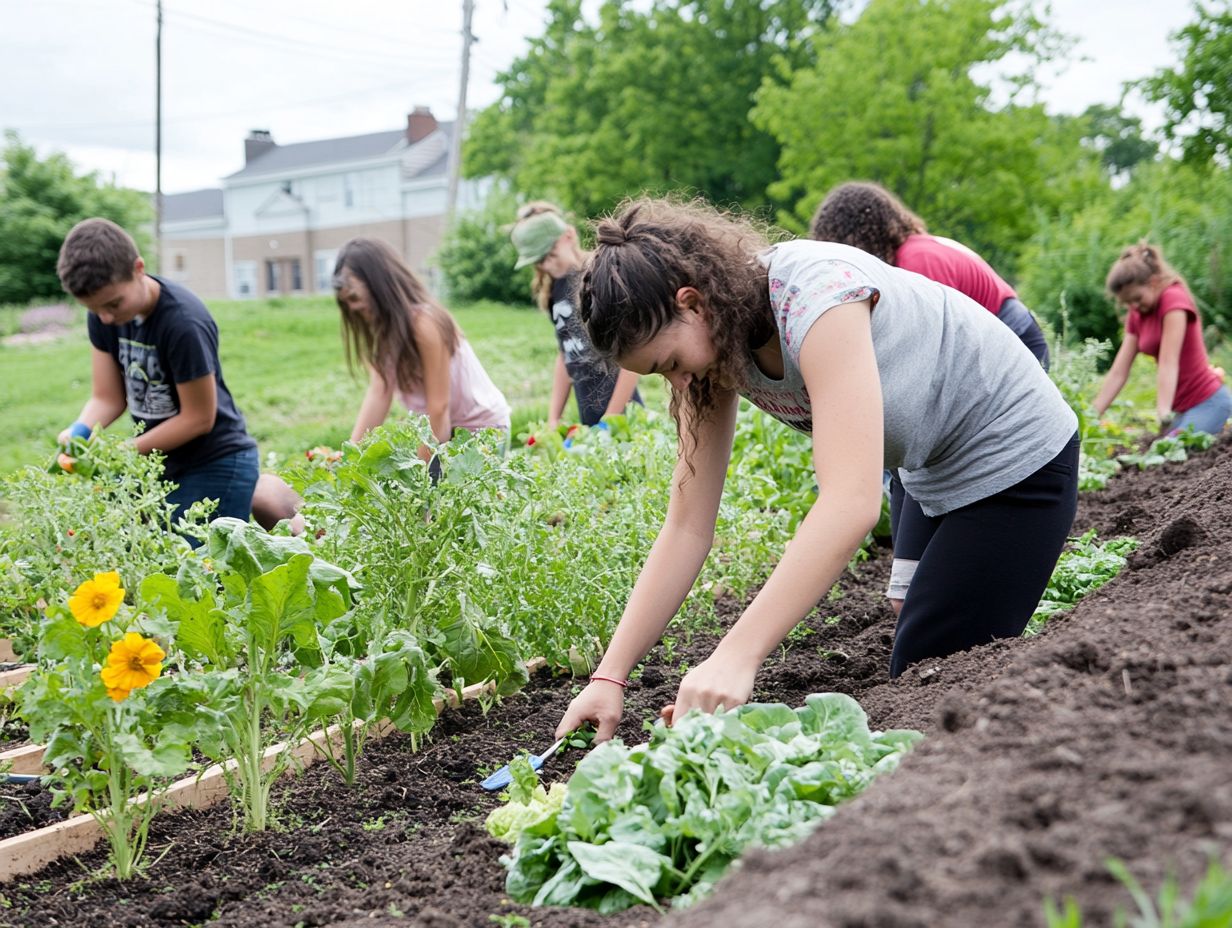
Encouraging youth to share their ideas and innovations within permaculture projects cultivates a vibrant culture of creativity and collaboration, empowering them to engage actively in the design process. To enhance their understanding, you might consider exploring how to teach kids about permaculture and ongoing implementation monitoring.
This approach sharpens individual skills and enhances design strategies by incorporating various perspectives. You can facilitate open discussions through regular brainstorming sessions, ensuring participants feel safe and inspired to express their thoughts.
Implementing feedback mechanisms, such as surveys or suggestion boxes, guarantees that every voice is both heard and valued. Furthermore, creating opportunities for observational interactions allows participants to learn from one another in real-time, solidifying the hands-on experience crucial in action learning scenarios.
These strategies create an exciting environment that sparks innovation and strengthens community bonds around shared goals.
6. Introduce Permaculture in Schools and Youth Organizations
Introducing permaculture principles in schools and youth organizations offers a remarkable opportunity to immerse young people in sustainable living practices while nurturing their ecological awareness and hands-on skills through environmental education.
By incorporating gardening workshops and outdoor learning initiatives, you can create enriching experiences that resonate with students, fostering a deep appreciation for the intricacies of natural systems. These programs serve as platforms for developing action plans that promote individual responsibility and cultivate a vibrant spirit of community involvement.
Integrating permaculture ethics into the curriculum enables learners to delve into crucial concepts like resource conservation and biodiversity, equipping them to make informed decisions that positively influence their surroundings. As students collaborate in gardens, they forge connections with their local ecosystem and recognize the significance of collective efforts in achieving sustainability goals.
7. Use Technology to Engage Youth in Permaculture
Utilizing technology to engage youth in permaculture elevates their learning experiences, presenting innovative design tools and resources that promote observation and interaction, ultimately deepening their understanding of ecological design.
By incorporating a variety of technological tools and platforms think interactive apps for garden layout and planning you enable young learners to visualize complex ecosystems and apply their knowledge practically. Online workshops and virtual classes broaden accessibility, allowing participants from diverse backgrounds to learn from experts around the globe, fostering a vibrant sense of community.
These technological tools can also aid in tracking the progress of permaculture projects, providing valuable feedback and data to help you adapt techniques for improved outcomes. Such digital enhancements not only stimulate engagement but also empower the next generation to make meaningful contributions to sustainable practices.
How Can Permaculture Benefit Youth?
Permaculture offers a wealth of benefits for you. It cultivates essential life skills such as responsibility and teamwork.
Through permaculture, you deepen your connection with nature and learn about sustainable living practices. By engaging in permaculture initiatives, you re not just growing plants; you re also nurturing your thinking skills and feelings and mood.
For example, when you participate in community gardens, you enhance your problem-solving and critical thinking abilities as you design eco-friendly landscapes. This hands-on involvement fosters a sense of stewardship towards the environment, leading to a profound appreciation for biodiversity.
Programs in urban schools show that these activities can boost mental health, reducing stress and building resilience. Such experiences empower you, equipping you with the mindset needed to create sustainable futures and navigate life s challenges with greater effectiveness.
What Are Some Examples of Successful Youth Permaculture Projects?
Numerous examples of successful youth permaculture projects illustrate the profound impact of involving young people in community gardens and ecological design. These initiatives, highlighted in 10 inspiring case studies in permaculture, showcase their remarkable ability to innovate and collaborate.
For instance, in a city neighborhood, local teens transformed a vacant lot into a vibrant community space. Through hands-on activities, they embraced sustainable farming techniques and developed essential skills like teamwork, critical thinking, and problem-solving.
Regular community meetings empower these young individuals to voice their ideas and actively contribute to the planning process. This fosters a genuine sense of ownership.
The design evaluation process was engaging, incorporating feedback loops that allowed participants to assess plant growth and community involvement. This collaborative approach led to a thriving garden, nurturing both personal and communal growth.
What Are the Challenges of Engaging Youth in Permaculture?
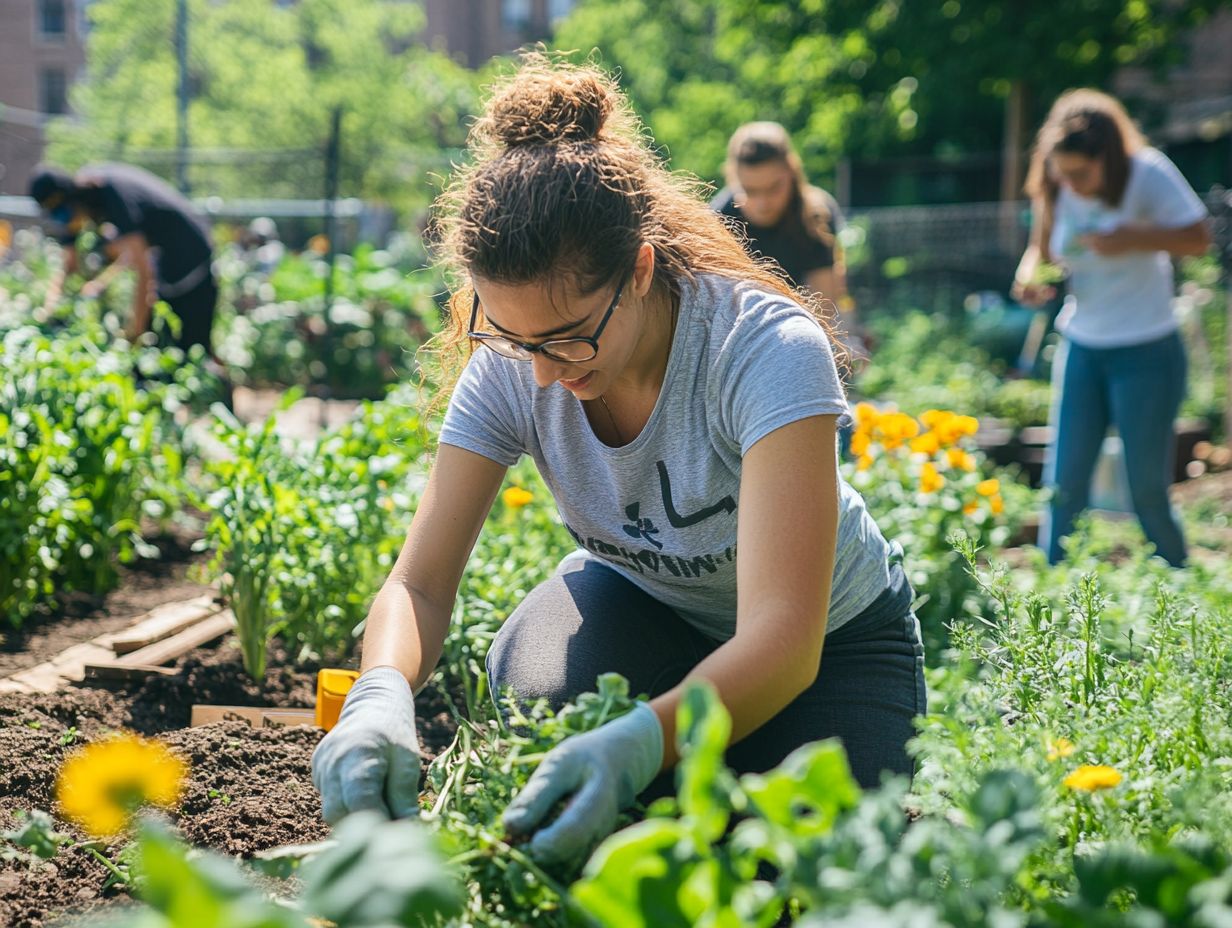
Getting youth involved in permaculture can be a fun adventure despite some challenges. There are varying levels of interest and logistical hurdles in organizing activities.
This calls for a flexible design framework that adjusts to their unique needs and preferences. To navigate these obstacles, it s essential for you to prioritize observation analysis and feedback evaluation.
By closely monitoring participants’ responses, preferences, and engagement levels, you can adapt your teaching methods and activity formats on the fly. Incorporating hands-on projects that resonate with their interests like community gardens or sustainability workshops can ignite excitement and make the learning experience tangible.
Creating an environment where young people feel comfortable sharing their thoughts can yield invaluable insights. This iterative process enriches their educational journey and empowers them to feel invested in both their learning and the broader permaculture movement.
Incorporating nature interaction and observation interaction techniques into workshops can deepen their understanding and appreciation for permaculture practices.
How Can Permaculture Help Youth Develop Important Skills?
Permaculture education plays a pivotal role in helping you develop essential skills like critical thinking, teamwork, and problem-solving through hands-on activities that promote engagement with nature and environmental awareness.
For example, participating in a community garden project allows you to collaborate with others to design, plant, and maintain the garden. This enhances your ability to communicate effectively while fostering a sense of responsibility toward the environment.
Designing rainwater harvesting systems encourages you to think critically about resource management, which means using natural resources wisely and sustainably. These experiences empower you to take initiative, engage actively in your community, and contribute positively to the world around you.
As you immerse yourself in these projects, you acquire practical skills and forge a deeper connection to nature, promoting personal growth and a shared commitment to ecological stewardship. These projects follow permaculture guidelines that emphasize the importance of nature patterns and seasonal activities.
What Are the Long-Term Effects of Engaging Youth in Permaculture?
Engaging youth in permaculture has profound long-term benefits. It cultivates a genuine commitment to sustainable living, fosters greater community involvement, and nurtures a deeper sense of environmental stewardship.
When young people participate in permaculture activities, they learn about environmental systems and sustainable practices while developing essential life skills like teamwork, problem-solving, and critical thinking.
Many who engage in these programs return to their communities as proactive citizens, championing local sustainability initiatives and inspiring a culture of responsibility toward nature.
As they tend to their gardens or create community plots, they cultivate not just food but also a sense of belonging and accountability. This experience shapes their future actions, ensuring they remain engaged in environmental advocacy as adults.
The ripple effect often inspires their peers and future generations to prioritize ecological health in their personal and community choices, promoting community projects that incorporate permaculture ethics.
How Can Youth Be Encouraged to Continue Practicing Permaculture in the Future?
Encouraging youth to embrace permaculture in the future is all about instilling a sense of ownership and responsibility through action learning and community projects that resonate with their interests.
Integrating mentorship programs allows young individuals to tap into invaluable guidance from seasoned practitioners who share their passion for sustainable agriculture. Ongoing workshops address current challenges and innovations, creating a dynamic environment for skill development.
This setting allows participants to experiment with fresh techniques while nurturing their creativity. Fostering community engagement initiatives cultivates collaboration, enabling youth to witness the tangible benefits of their contributions.
Regular feedback and evaluations act as powerful motivators, helping them grasp their progress and identify areas for improvement. This reinforcement strengthens their commitment to permaculture practices, ensuring a vibrant, lasting interest in their journey through gardening workshops that focus on implementation and maintenance.
Frequently Asked Questions
Discover more about permaculture and its importance for youth engagement.
1. What is permaculture and why is it important to engage youth in it?
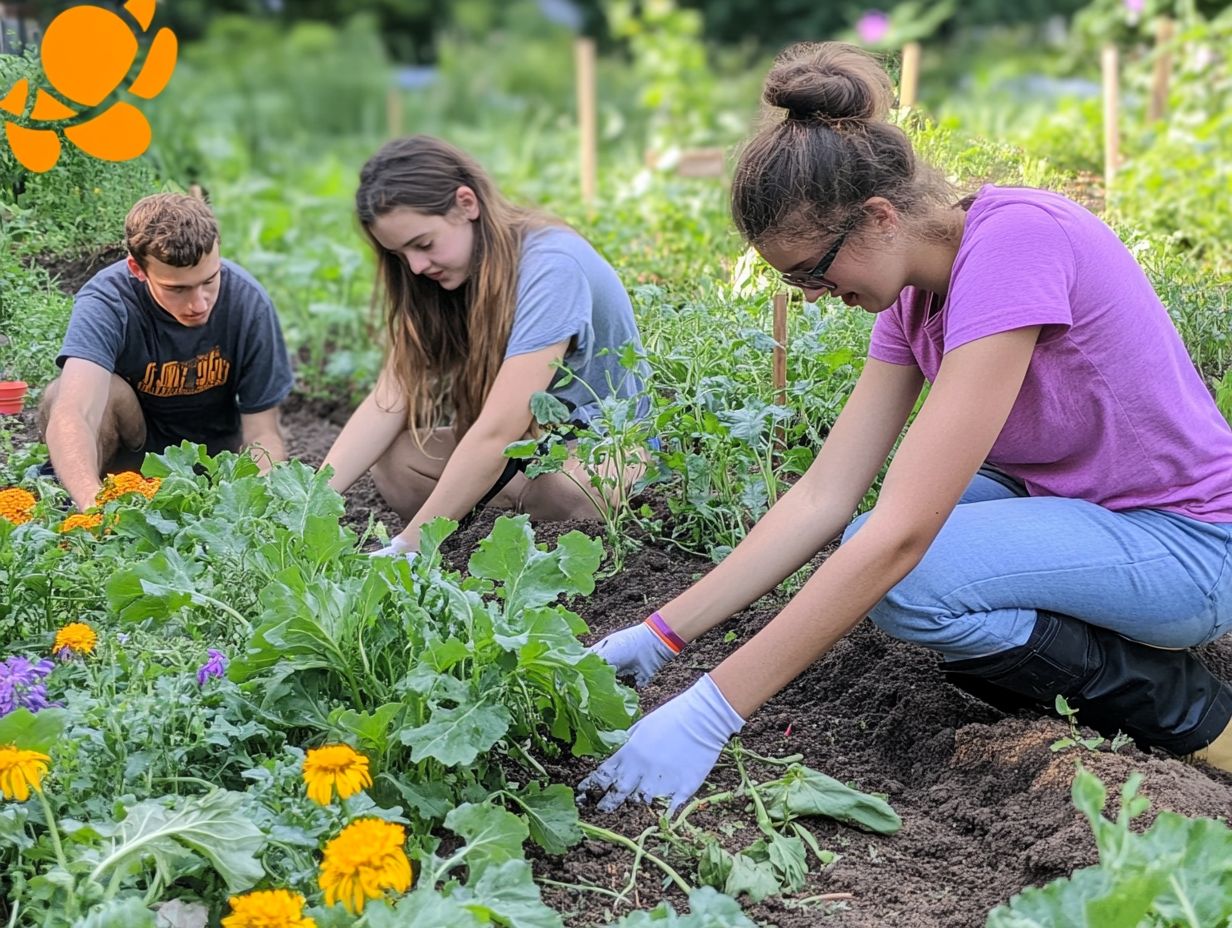
Permaculture is a holistic approach to sustainable living that focuses on designing and maintaining resilient agricultural ecosystems. Engaging youth in permaculture is crucial because they are the future caretakers of our planet and can significantly contribute to creating a more sustainable future.
2. How can I get youth interested in permaculture?
One creative way to engage youth in permaculture is to host educational workshops or hands-on activities that involve them in the design and implementation of permaculture principles. This allows them to have hands-on experiences and see the impact of their actions.
3. What are some fun ways to teach youth about permaculture?
Engage youth in permaculture through fun activities. Consider games, art projects, or field trips to local permaculture farms, and explore creative fundraising ideas for permaculture to support these initiatives.
This makes learning about permaculture enjoyable and engaging for young minds.
4. Can permaculture be integrated into school curriculums?
Absolutely! Permaculture principles can be integrated into various subjects such as science, math, and social studies.
This teaches youth about sustainable living. It helps them apply their knowledge in real life.
5. How can I involve youth in permaculture projects in their communities?
Youth can be involved in permaculture projects in their communities by organizing community clean-up events, starting community gardens, or participating in local permaculture initiatives.
This empowers them to take ownership and create a positive change in their neighborhoods!
6. How can I support youth who are interested in permaculture?
Support youth interested in permaculture today! Provide resources and connect them with like-minded individuals.
Encourage them to take on leadership roles in permaculture projects to foster their passion for sustainable living.



